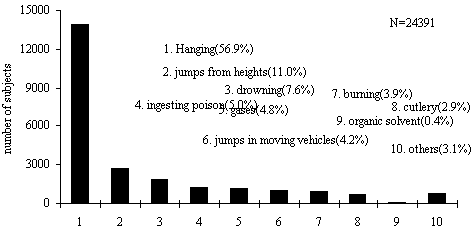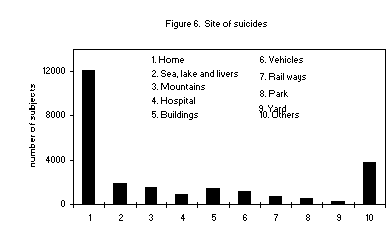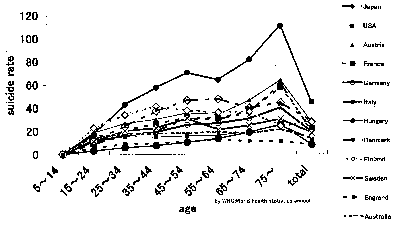

|
Медико-биологический
информационный портал
|
|
для специалистов |
|
ТОМ 4, СТ. X (сc. X) // Апрель, 2003 г.
STUDIES ON SUICIDE AMONG JAPANESE(1) M. Aihara1, H. Aihara2 1 Department of Public Health and Hygiene, Shonan Junior College 2 Department of Legal Medicine, Yokohama City University School of Medicine Summary
The total number of suicides was 24,391 among a Japanese population of 130,000,000 (according to the 1997 statistics), or 19.3 per 100,000 people. Compared with the statistics for the previous year (1996), this was an increase of 1,287 or 5.6%. The authors investigated factors such as age, motives, site chosen, method, and the month in which the suicide occurred for 1997. An increase in the number of incidences was noted for all ages beginning with those in their 20s. In particular, there was a high incidence for those in their 30s (266, 10.6%), while for those under 20 years of age, there was a decrease. The most frequent motive for suicide was illness (37.1%), followed by mental disorders (18.9%) and economic difficulty or problems with their personal situation (14.6%). The sites chosen for the scene of suicide were the individual's residence (49.5%), followed by the ocean (lakes), rivers, high-rise buildings, mountains, and hospitals. The suicidal method selected most frequently was hanging (56.9%), followed by jumping from a height (11%) and drowning (7.6%). The incidence was highest in May and low in February, December, and January. In Japan, 16.7% of the total population is now over 65. Suicide is near the top of the causes of death among the aged. When the suicide victims are stratified by age, 6,409 (26.3%) are over 65, followed by those between 50 to 59. Suicide is rare among young people. Many of the aged suffer from chronic conditions, such as hypertension and cerebrovascular disorders; but the incidence of malignant neoplasms is low. For many of the patients with mental disorders, depression, neurosis, schizophrenia, senile dementia, and depressive responses to somatic dysfunctions are cited as the motives for suicide. It is believed that suicidal ideation is fanned by psychosocial factors, such as loneliness and general pessimism.
Introduction
The total Japanese population is approximately 130 million, and the annual number of deaths in 1997 was 913,402, among which the number of suicides totaled 24,391, making suicide the 10th the most common cause of death among Japanese. The suicide rate is 19.3 per 100,00 population, and it has been tending to increase year by year. Using the data for 1997 as the baseline, there was an 8,261 increase in suicides the following year, 1998, and relative and absolute increases are predicted in the future. The elderly make up 16.7% of the total population of Japan, and the mean life expectancy is 77.16 years for males and 84.0 years for females, making Japan the country with the longest life expectancy in the world. Suicide, however, is a higher ranking cause of death among the elderly, with suicides by elderly persons accounting for 6,409 of the 24,391 suicides in 1997, and it was most common among the elderly, who represented 26.3% of the total. There are disparities between the suicides statistics in the vital statistics of the National Police Agency and the Ministry of Health, Labour and Welfare, and there are also differences between their handling and reporting of survey subjects, survey times, and multiple suicides. The objective of the present study was to deepen awareness by reporting the current situation regarding suicide in Japan, the country with world's longest life expectancy, to promote support for people's mental health, and to prevent suicide and parasuicide1).
Methods
By referring to the vital statistics of the Ministry of Health 2), Labour and Welfare and National Police Agency data on suicides by Japanese in combination with the postmortem examination reports on suicides carried out in Kanagawa Prefecture, we determined the current situation in regard to suicides and conducted a forensic medical assessment based on their characteristics.
Result
Changes in numbers of suicides from 1955 to 1997 and gross national expenditure (GNE) The most common causes and motives for suicide among persons in their 30s to 50s were economic-livelihood problems. This figure shows the relationship between economic conditions and suicide. GNE is shown as a percentage of the GNE the previous year. Suicides were governed by economic conditions, peaking in the economic downturn years of 1958, 1967, 1971 and 1974, and they have been rising again since 1997 (Figure 1.).
Figure 1. Changes in numbers of suicides from 1955 to 1997 and gross national expenditure.
Figure 2 showed Gender and suicides in 1997. Suicide rate sex ratio = male suicide rate/female suicide rate в 100,000. Male suicides were far more common in 1997, and in approximately 65% of the total there had been a warning sign, e.g., in the form of the person's speech or behavior, a suicide note, or a history of attempted suicide.
Figure 2. Gender and suicide in 1997.
Numbers of suicides according to age, Young persons (under 20 years of age), adults, and the elderly people. An increase in suicides compared to the previous year was observed among persons in their 30s, and there were increases in every age bracket, 20s, 40s, 50s, and 60 and over. There was a decrease in suicides among those under 20 years of age. Those 65 and over accounted for 26.3% of the total (Figure 3.).
Figure 3. Numbers of suicides according to age.
Figure 4 showed distribution of suicides according to month. When suicides were tabulated according to month, the highest percentage of the total, 9.5%, was found to have occurred in May, and the lowest percentage, 7.3%, in February. Distribution of suicides according to method, hanging was the most common method of suicide, accounting for 56.9% of the total, and was followed in descending order by jumps from heights, drowning, ingesting poison, use of gases, and jumping into the path of a moving vehicle (Figure 5).
Figure 5. Distribution of suicides according to method.
Figure 6 showed the site of suicides. According to site, the person's home accounted for 49.5% of the total, and was followed in descending order by the sea or lakes, rivers, mountains, tall buildings, vehicles, and hospitals.
Figure 6. Site of suicides.
Relation between suicide method and site. The most common site of hanging and poisoning for both males and females was the home. Drowning was most common in rivers and lakes/marshes, and drowning in the bath at home was also common among women. Small firearms are a method that is being seen recently, and the most common site has been the home. The most frequent sites of jumps from heights by both males and females are tall buildings and hospitals. Jumps in front of moving vehicles by both males and females most often involve railroad tracks, and use of motor vehicle exhaust is the most common method of suicide by gas (Table 1). Table 1. Relation between suicide method and site
-----------------------------------------------------------------------------
Method ranking of the place M: Male
F: Female
-----------------------------------------------------------------------------
Hanging M home mountain others
F home others hospital
-----------------------------------------------------------------------------
Poisoning M home others mountain
F home others mountain
-----------------------------------------------------------------------------
Drowning M sea.lake pond others
F sea.lake pond home
-----------------------------------------------------------------------------
Small arms M home office mountain
F home - -
-----------------------------------------------------------------------------
Jumps from M building hospital others
Height F building hospital home
-----------------------------------------------------------------------------
Dives M rail ways sea.lake station
F rail ways station sea.lake
-----------------------------------------------------------------------------
Gases M car home others
F car home others
-----------------------------------------------------------------------------
Distribution of suicides according to age and motive. School problems were the motive in both males and females in the 10 to 14 year group and 15 to 19 year age groups. Work-related problems, problems involving relationships between the sexes, and school problems seemed to be in the background among those in their 20s. Among those in their 30s, 40s, and 50s, suicides in which economic problems were a predisposing cause were reported in men, and they were particularly common in the 50s. Family problems, economic problems, work-related problems, and mental disorders were widespread among those in their 40s, while problems involving relationships between the sexes were prominent in the 20s and 30s. In the 50s and 60s, illness was particularly common among both men and women, and the illnesses consisted of malignant tumors, heart disease, hepatitis, etc., and none of them were diseases that took an acute course (Table 2).
Table 2. Distribution of suicides according to age and motive
------------------------------------------------------------------------------------
Problems/ age 10-14 15-19 20-24 25-29 30-39 40-49 50-59 60-64 65-unknown
------------------------------------------------------------------------------------
Family M 269 257 304
F 149 147 309
------------------------------------------------------------------------------------
Illnesses M 1241 718 2175
F 618 342 1988
------------------------------------------------------------------------------------
Economic M 390 882 1138
F 89 94 49
------------------------------------------------------------------------------------
Work related M 241 305 314
F 16 19 13
------------------------------------------------------------------------------------
Sexes M 88 80 89
F 56 51 52
------------------------------------------------------------------------------------
School M 11 82 67
F 5 19 11
------------------------------------------------------------------------------------
Mental dis. M 494 543 517
F 378 465 369
------------------------------------------------------------------------------------
Others M 165 189 252
F 41 47 215
------------------------------------------------------------------------------------
Unknown M 203 277 217
F 42 51 72
------------------------------------------------------------------------------------
Comparisons with suicides in other countries. The criteria for judging whether a death is a suicide depend on the decisions of the medical examiner, and as a result even the figures reported by the WHO vary from country to country. The male and female suicide rates per 100,000 population among the elderly in Japan are second only to those reported by Hungary (Figure 7).
Figure 7. Comparisons with suicide.
Discussion
The growth of the Japanese population has been accompanied by an increase in the number of deaths by suicide. Examinations of the suicide death rate in relation to the total mortality rate reveals that suicides among the elderly accounted for 26.0% of all deaths in that age group in 1997, and accounts for the highest mortality rate by suicide ever. In addition to the suicide figures shown, there are parasuicides and many unclear cases in which it is impossible to judge whether the death was an accident or suicide. This tendency can be recognized when they are added in as well. Suicides in Japan are divided into the two peaks in the Western pattern: in the 50s and 65 and over groups. When males and females are compared, the higher number of males and lower number of females in other countries is said to be attributable to males' assertiveness and executive ability always exceeding that of females. However, one reason why suicides by females are more common in Japan than in other countries is the difference in the number of females in the elderly population 3). The total population of elderly persons 65 years of age and over in Japan is approximately 21,180,000, but because the elderly population consists of 8,816,000 men and 12,369,000 women, there are 1.4 times as many women as men. The gender differences are small in the suicides attributed to illness and mental disorders. It will also be necessary to elucidate motives classified in other ways 4). Yoshioka 5) divided the living environment of persons who committed suicides in Akita Prefecture into "living alone" and "living with others" and found that suicides were far more common among those who lived with others. The number of elderly living alone has increased to 2,703,000 households in recent years, but even living with others cannot be concluded to provide a solution to loneliness or fulfill the need to have someone to rely on.
Conclusion
Looking at the figures shows that illness, economic problems, and mental disorders are important among persons in the 50s and 65 and over groups. Improvements in medical care and mental health appear to be very effective. More specifically, while illness is the motive for many suicides, the illnesses could not be said to be immediately life-threatening diseases in every case. Even young people who these days are inundated with information and are actively exchanging it but are surprisingly isolated in terms of their innermost thoughts share something in common with middle-aged and elderly people who confront each other in society but in reality are isolated in its midst. It will be necessary to determine the actual situation regarding suicides by means of forensic medicine and seek to provide mental health and a social environment that are deeply rooted in people's lives.
References
|
||||||||||||||
| Размещение рекламы | |
|
| |

 Articles
Articles
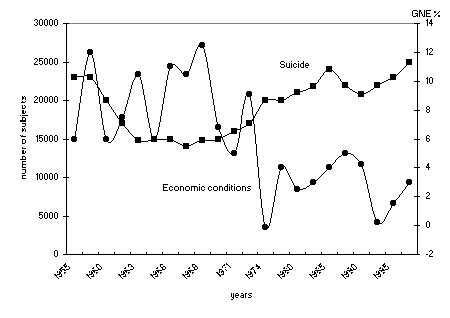
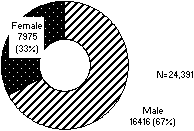
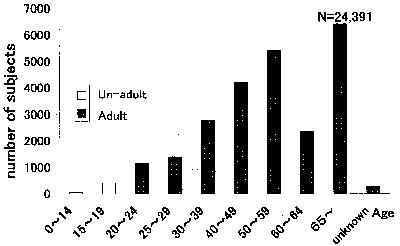
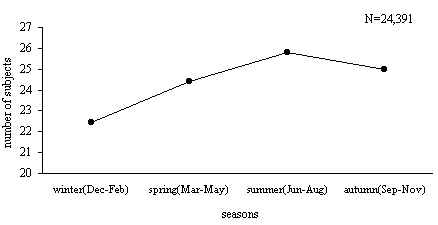 Figure 4. Destribution of suicides according to month.
Figure 4. Destribution of suicides according to month.
